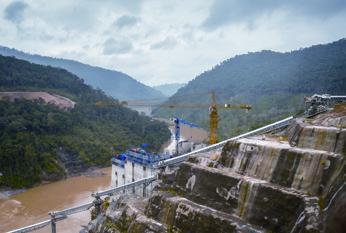BUILDING A REPUTATION
By Ma Miaomiao
In February, when the novel coronavirus disease (COVID-19) had started to affect production, construction and other economic activities, construction on the China-Laos Railway in Laos continued in full swing, without any disruption in material supplies.
One essential supplier to the project, which will transform landlocked Laos into a land-linked transport hub in the Indochina Peninsula, is PowerChina, the worlds largest power construction designer and contractor. The Chinese company entered the Laos market over two decades ago and since 1996, has been participating in the construction of local infrastructure such as hydropower plants.
In 2017, it started operating a cement factory with a capacity of 1 million tons per year and it is this factory that is providing cement for the China-Laos Railway. The factory staff has been working in shifts since the outbreak of COVID-19 to ensure prompt delivery of orders for the railway and other construction projects.
PowerChina has supplied more than 610,000 tons of cement to the China-Laos Railway, a major project under the Belt and Road Initiative.

The company is also involved in other key projects under the initiative, such as a coal-fired power plant in Port Qasim in Pakistans financial capital Karachi, and the Jakarta-Bandung High-Speed Railway in Indonesia.
The contributions have now been acknowledged afresh with PowerChina ranking 157th on this years Fortune 500 list, up four spots from last year.
“COVID-19 has not slowed down the pace of our work,” Fazal Rahim, a business manager at the Karachi power plant, told China Daily. “The credit goes to the management and workers, both Pakistanis and Chinese.”
“Operations remain stable at the plant. Not a single worker has contracted the virus so far,” Xi Peng, deputy chief representative of PowerChina in Pakistan, said. All employees have been taking precautionary measures such as wearing masks in public places, washing hands frequently and avoiding mass gatherings.
The power plant is one of the key energy projects in the China-Pakistan Economic Corridor, jointly developed by PowerChina and Qatar-based investment company Al Mirqab Capital. Once completed, it will meet the electricity needs of 4 million households.
On March 30, PowerChina, along with five other Chinese companies in Pakistan, donated anti-epidemic materials and funds worth $40,824 to the Pakistan Institute of Medical Sciences and Pakistans National Disaster Management Authority.
Other overseas projects of PowerChina are also running in an orderly manner. They have played a significant role in stabilizing global industrial and supply chains and contributed to Belt and Road cooperation as well as the recovery of the world economy.
On August 5, 148 PowerChina staffers arrived in Belgrade from China on a charter flight. After self-isolation for 14 days, they returned to their posts at projects in Serbia, Bosnia and Herzegovina, and North Macedonia. Their arrival helped address the shortage of personnel on site and promoted the restart of those projects.
In Zambia, PowerChina is building the 750-mw Kafue Gorge Lower Hydro-Power Station. Once completed this year, it will enhance Zambias power production capacity to 3,650 mw from the current 2,900 mw. Victor Mundende, Managing Director of Zambia Electricity Supply Corp., told Xinhua News Agency the project would significantly reduce the prevailing power deficit.
Using the profit from the project, PowerChina has funded a school to provide vocational training for locals. The school will be handed over to the Zambian Government upon completion, according to Song Shiwei, an official in charge of the companys overseas projects.
Currently, PowerChina has 70,000 local employees working on its projects abroad, creating more than 200,000 jobs and improving the livelihood of local people.

